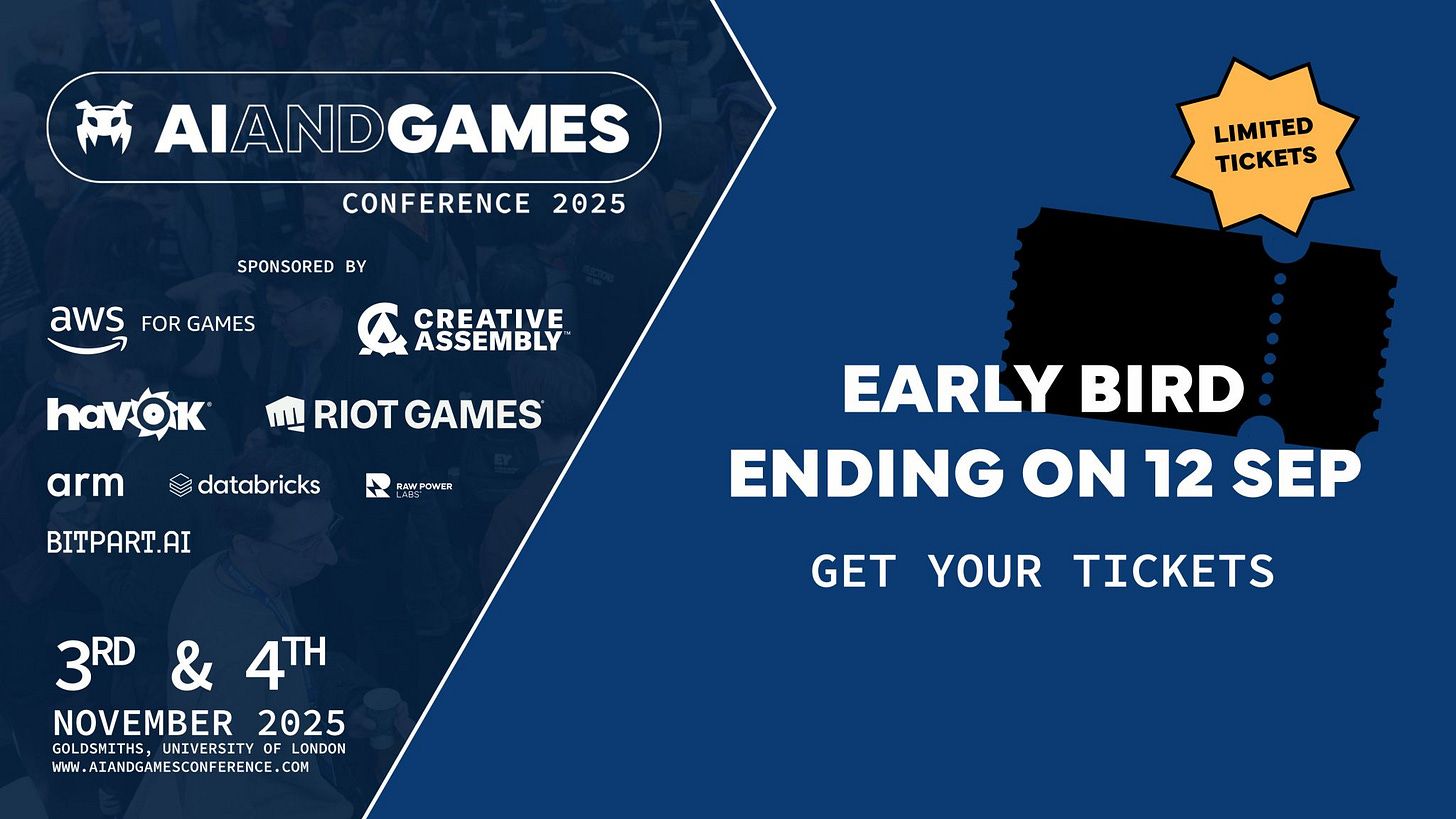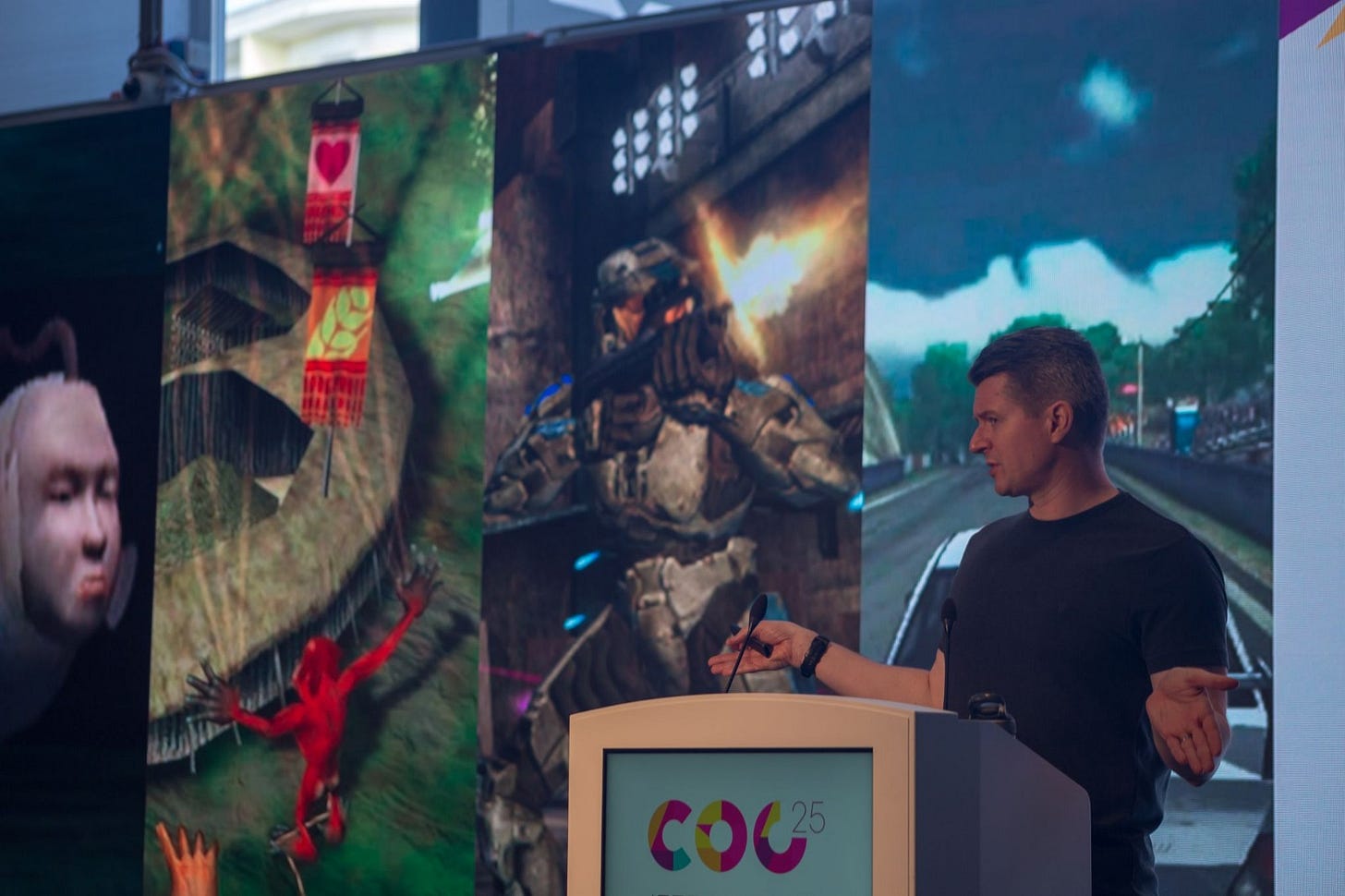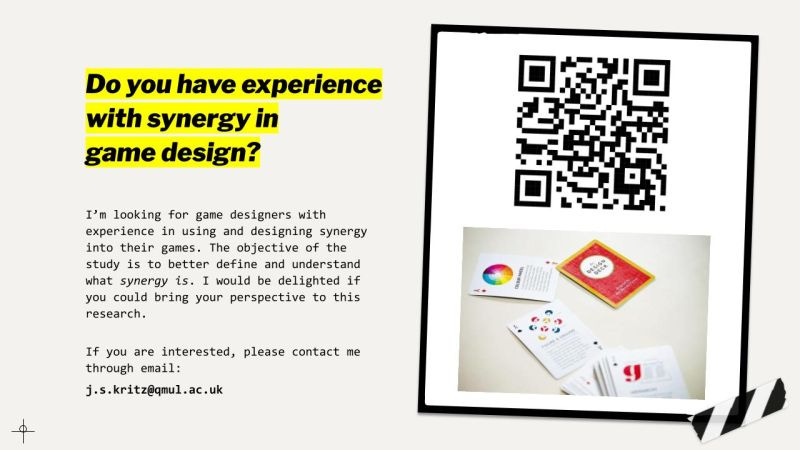Investor Perspectives of the Generative AI Gaming Landscape | 03/09/25
We sit down with Carli Stein and Cassia Curran to learn how investors perceive generative AI in games.
The AI and Games Newsletter brings concise and informative discussion on artificial intelligence for video games each and every week. Plus summarising all of our content released across various channels, like our YouTube videos and in-person events like the AI and Games Conference.
You can subscribe to and support AI and Games, with weekly editions appearing in your inbox. If you'd like to work with us on your own games projects, please check out our consulting services. To sponsor, please visit the dedicated sponsorship page.
Hey all, welcome back to
! After a couple of weeks of touring around events I’m largely answering emails, and trying to remember how to parry in Expedition 33 - not to mention recalling what my job is.Anywho, this week we have something special. We sat down to chat with investors in both the AI and gaming spaces to get their take on where things are going in the immediate future.
But first, strap in and let’s run through some announcements!
Follow AI and Games on: BlueSky | YouTube | LinkedIn | TikTok
Announcements
We have some quick announcements, starting with our very own event!
AI and Games Conference 2025
A couple of quick announcements as our gathering in London is a mere two months away(!!!)
Decision Emails Out This Week!
As mentioned in last weeks newsletter, decision emails go out this week to everyone who submitted to our open call. Thank you once again for all your efforts, and we look forward to announcing the programme starting later this month!
Early Bird Ticket Sales End September 12th
Short but sweet, we’re ending the early bird ticket sales next Friday, September 12th. At which point regular sales will go live! Grab your tickets now at the conference website.
Special Thanks to IEEE Conference on Games
A quick message to thank the organisers once again for having me present as a keynote speaker at the IEEE Conference on Games in Lisbon last week. The talk was a reflection on 20 years of the conference itself, and how it evolved from a small symposium hosted at the University of Essex in the UK in 2005 to one of the largest dedicated events for academic research in games.
I’ll be back on the newsletter in the coming weeks with an update on some of the presentations that I saw during my time there.
Participants Wanted to Game Designer Study
PhD student Joshua Kritz at Queen Mary University of London is currently seeking game designers who would be willing to offer their time to participate in an ongoing study as part of a an academic research project. I was chatting with Joshua while at IEEE CoG last week and he asked if I could help promote the study, and so here we are!
If you or your peers feel you could contribute, you can get in touch with Joshua via the email address in the image above, via the QR code, or visit Joshua’s post for the study on LinkedIn.
Investors Perspectives on the AI Gaming Landscape
Our big topic this week is a deep dive into the perspectives on AI in the games industry from an investors point of view. To that end, please welcome Amit Goyal who has done the hard work of writing up my recent conversations with our two wonderful guests. Delivering it in a nice and shiny narrative. Amit, the floor is yours!
It’s no secret that the games industry has had a tumultuous last few years. Ever since the economic boom brought by COVID lockdowns, the years that followed have not been kind. Over 20000 people lost their jobs between 2023 and mid-2024, and there seems to be no respite in 2025 either, after all we only recently discussed the 9000 job cuts at Microsoft, primarily within its Xbox division. Plus our own predictions for 2025 included the bleak outlook of continued lay-offs well into 2026.
However, let’s not dwell all apocalyptic-like about the state of the industry. Rather let’s discuss the elephant in the room. The layoffs have occurred alongside the rise of generative AI, and this has been an ongoing conversation in this newsletter about how tremendous amount of resources are being poured into the technology as studios explore the efficacy of this technology in their existing workflows - a point we discussed last week from Tommy’s conversations with developers at Gamescom.
The steady march of generative AI in the games industry remains undeterred by the marked shift in the attitude of game developers towards it. In the 2025 State of the Games Industry report by GDC, 30% of the respondents said that generative AI is having a negative impact on the games industry, up from 18% last year. Over half the respondents raised serious concerns around the ethics surrounding the use of generative AI.
While the lay-offs in the games industry are (mostly) not attributed to generative AI, there is a loose connection between the two: as lay-offs continue, there is still a lot of investment being pumped into the sector. Be it to create new indie studios, but largely for the creation of start-ups interested in exploring AI either for game development, or the creation of new ‘AI-native’ games, where generative AI is a core part of the experience.
But even now, as investors are becoming increasingly spooked by the speculative nature of the AI boom, and companies AI pilots are failing, we had a couple of questions:
What are investors looking for right now in new AI start-ups?
What are the things they’re interested in investing in?
What impact is generative AI having on the games being pitched?
What challenges are both start-ups and investors facing in this current market?
To find out more about this, we sent
to chat with two investors on opposite sides of the AI/gaming investment space.Carli Stein: Who until recently was a senior associate at M12 - Microsoft’s venture capital fund, and was a board observer for game/AI start-up modl.ai
Cassia Curran: A games-focussed investor and founder and chief consultant at Curran Games Agency. With previous experience at NetEase, Jagex and WINGS Interactive.
Without further ado, let’s get into it!
The Playing Field
Carli Stein: “[There is] a ton of capital sloshing around in the ecosystem, especially in the AI ecosystem where I spend most of my time. I think more capital has gone into the AI ecosystem than any other venture space in the past few years. The rest of the market is honestly down in terms of investment, but AI investment is very much up year over year.”
Both investors were of the opinion that investments in generative AI will continue to dominate the technology sectors investments. In fact, Curran felt that generative AI has cannibalized some of the investment space occupied by games. According to her, the reason for this is two-fold. The first is the continued downward trend in gaming revenues since the COVID era:
Cassia Curran: “There's no real obvious growth area in the games industry to focus on. A lot of the growth in areas has been sort of tapped out. Like, mobile [gaming] is pretty saturated now. And that drove a lot of growth through the last 10 or 15 years. And you [are] also seeing the rise of social video, eating into people's limited leisure time, which was what games took up before. So, it's been very, very challenging for games prospecting and financing.”
The other reason, is that games may not be the field where AI has the maximum potential for disruption, and investor interest will be maximum in spaces where AI can change the fundamentals of how an industry operates - such as law and healthcare. This does not mean that there is no interest in investment in gaming, but the value proposition needs to be clear and unique, something we will delve into some more later on.
In terms of AI in games specifically, both investors identified two broad areas that will see influx of capital:
AI for game development: Tools powered by AI to support game developers.
AI for content: This is largely being driven by the aforementioned AI native games where generative AI is a critical part of the core gameplay experience.
This is not exactly a new concept. AI native games have existed as far back as 2005’s Façade - a first person interactive drama that we covered on the AI and Games YouTube channel in 2020! However, that game was much more structured in nature - relying on hand-craft drama systems - and while a cult classic it did not achieve a broader widespread popularity. With new advancements in the field, we are seeing a new crop of commercially targeted AI native games that seek to capture the imagination of the broader gaming populace. Curran is keenly watching how this space unfolds, as they expect this utilisation of generative AI to create entirely new types of gameplay experiences.
However, there is a degree of scepticism around it as well - fuelled largely by the empty promises in the past made by blockchain, metaverse and NFTs to change the face of the games industry. How things turn out with generative AI native games remains to be seen, so we turn to the other major application of generative AI in games - tools.
New Tools of the Trade?
Unlike AI-native games, there has been a lot of buzz around the generative AI tools for game development. And while we’ve heard many an empty platitude in recent months (especially if you read the news segment of the newsletter), we’re also now seeing some very real use cases beginning to emerge.
AI is often perceived as the tool that large publishers hope will be the antidote to the rising costs of AAA game development. From automation of standard processes to the application of large language models for user-generated content. In alignment with the AI’s existing impact on game development processes, Stein sees great potential in this space. She also pointed out some of the newer developments, such as the attempts to create efficient AI coding platforms and the applications of AI for publishers, especially in areas such as marketing automation.
That is not to say that there aren’t any challenges. As many of our lovely readers will know, there is no real standardisation when it comes to the process of making games. The democratization of game engines in the past decade has led to some degree of standardization, but factors such as team composition, skillset, game genre and the specifics of design make it almost impossible for significant process standardization, and both investors saw it as a major challenge for the development generative AI tools that could be applied across the board.
Stein: “You'll find a lot of the tooling might be like a point in time tool or a tool that does really well for one type of animation or one type of character creation. But it's not as much of a whole platform that teams can collaborate on and build over time and can be used throughout the game development lifecycle. And so I think about how sticky will this platform be, will it be used throughout the lifecycle of the game? Will it be something that people will come back to use continuously or only have to use once and then not think about it again? And so really that long term value and stickiness, and, and that ultimately drives willingness to pay.”
But the technological challenges, while complicated, may be solved in time. The bigger challenge facing generative AI in games lies elsewhere...
The Human Factor
Stein: “Thinking back to 2022, when the generative AI wave took off, we were in the forefront here of seeing those initial waves of Dall-E taking off and Midjourney taking off, and these initial consumer applications for creating generative content. And we realised that this is really about a change in consumer behaviour more broadly. And we're seeing after three years now, people are using ChatGPT more than any platform for consumers that they typically were using. It's up there with social media in terms of usage now.”
There’s no denying that generative AI has captured the imagination and attention of people at large. However, the relationship between generative AI and consumers is more complex. Like game developers, consumers often react negatively to the use of generative AI for video game production. As we discussed recently, this is mostly due to the lack of clarity in the value offered by the use of generative AI. In the absence of this clarity, consumers associate the use of AI as a replacement of human developers, and consequently, a drop in quality.
While a few games, such as The Finals by Embark Studio, and the critically acclaimed Clair Obscur: Expedition 33 have come out unscathed, most games using generative AI have been relegated to the status of shovelware or “slop”. Like consumers and developers, publishers and investors are also divided in their perception of AI:
Curran: “I see [AI art] in pitches a lot these days. People, instead of using concept artists, use Midjourney to spit out some AI art, which reflects the vibe of what they're aiming towards.
I don't have a strong opinion on this, but I note that there are strong opinions that I've heard from other publishers and investors.
Some publishers say ‘any pitch I see with AI art, I just put it in the bin because it's disrespect. It's stealing other artists’ work. It's environmentally unfriendly. It shows that you don't have the creativity yourself’. [Meanwhile] I've heard from investor funding types that it is fine because just sort of wanting to demonstrate a vibe very fast. We don't expect you to spend lots of money on the concept artist when there's this avenue that's easily available.
And so I can see both points of view, to be honest. And I think it might depend quite a lot upon your target audience. So if you are going for the indie game prestige sort of market, I wouldn't want to see AI in the art on the pitch.”
We are witnessing a sort of divide in the industry along the above lines. While publishers like Electronic Arts are hailing generative AI as the future of AAA game development, as seen in their most recent investor conference, indie developers like Alex Kanaris-Sotiriou are working on initiatives like the “No Gen AI” seal of approval.
That said, Curran is of the opinion that AI-native games will find acceptance among gamers provided they make good on their promise of new and unique gameplay experiences. That’s a case of clear value proposition for the end consumer, and something that studios working on AI native games should have a clear plan to communicate to their audiences.
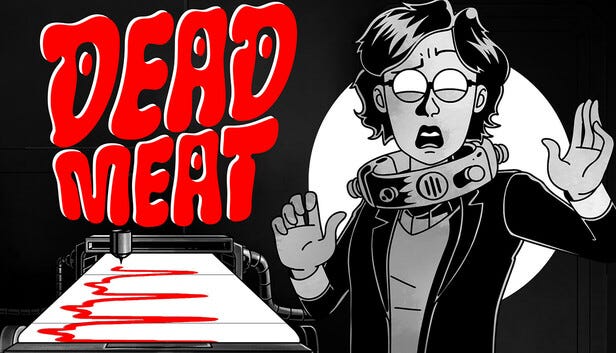
But how should an indie developer leverage the value offered by AI tools in the current environment? Well, don’t get caught - or rather, do not use AI tools to the extent where it becomes obvious. But bad optics is not the only disadvantage of the negativity surrounding the use of generative AI for game development. Curran has observed hesitation from publishers in funding AI-native games, even when they have genuine value and new gameplay experiences to offer.
Securing Funds
So how is the current trend of generative AI affecting the relationship between start-ups and investors? Right off the bat, Stein talked about how the modern tech investment landscape is very different from how things used to be but a few years ago - even without factoring generative AI into it.
Stein: “A lot of the fundamentals and principles that people might have used to make investments ten years ago, are no longer the principles that are being used today in the market. Valuations that are much higher than they should be at a series A or series B. Companies are raising in between rounds, like, they could raise a seed round and six months later are raising [Series] A when it used to be planned for 18 to 24 months later. You know, it used to be 1 million (USD) of ARR (Average Recurring Revenue) for a series A. Now companies are raising with no revenue or have gone 0 to 10 in six months. So it's really crazy fundamentals right now.”
Further, Stein emphasized that with the amount of capital floating in tech investments, it is a two-way street where start-ups must find the right investment partner - someone who aligns with their values, and someone who offers more than just capital, be it their network, their ability to connect them with other distribution ecosystems, or access to the right talent. She gave the example of the potential benefits associated with partnering with her previous employer M12:
Stein: “... anything from access to commercial partnership opportunities, access to technical resources. We have amazing AI models and great access to developer tools and Azure. A lot of it also is technical folks within the company that we can introduce our founders to. And in addition to that Microsoft customers often become a great channel for Start-Ups that we work with. And so those are just some ways that M12 provides value to the founders that we work with. And so I think really understanding what your investors bring to the table beyond cash is even more important today in this environment than it ever has been, because you could take cash from anyone.”
Securing the Funds
With more start-ups and more AI-native games on the horizon, the availability of capital and interest from investors bodes well for both generative AI’s continued push into games. But what is the sweet sauce that means publishers and investors are keen to start providing the funds?
From a game publishing standpoint, it’s business as usual. The two most important factors remain the team and the prototype:
Curran: “... [is] the team agile enough or smart enough? Do you believe in the team enough? It's easier for me to invest in a game, or to find investment for a game. If there is some sort of prototype that is really fun. You can just tell that the core gameplay has got it… [the] magic you need. That can be subjective, but sometimes it’s the only thing you've got to go on.”
In areas such as AI-native games, the prototype might not be there, or not in the stage where it can reliably convey the core gameplay experience. In these scenarios, the pitch itself has to be the star of the show. That said, securing publisher funding in the current circumstances is an uphill task.
Curran: “So it's quite simple in a way. Do I want to play this game? And then it's like, oh, can you actually make this game? And so seeing what indicators are there that they can do that. So have they worked before or have they shipped a game before? And the biggest green flag of all would be a vertical slice. And because you have 2000 pitches a year and there's less and less publishers funding, publishers can now afford to be more picky. They can afford to wait and invest in games which de-risk themselves by funding games, further along that cycle. It's always been tough for developers to find funding and it's just gotten even harder I'm afraid.”
As has been observed by many an indie developer in recent years, it’s arguably more practical to approach publishers further along in development that pitch stage - which isn’t ideal given publishers are meant to help with funding development. But equally you can see a narrative forming where generative AI tools hold value for some indie developers. If it can speed up the production of the prototype, it can be used to secure funding for the game more quickly, and then portions of the game done using generative AI can be rebuilt. Finding the right balance between handcrafted and generated elements in the pitch will be essential here, as too much generated content can work against the pitch and obfuscate what the team is capable of.
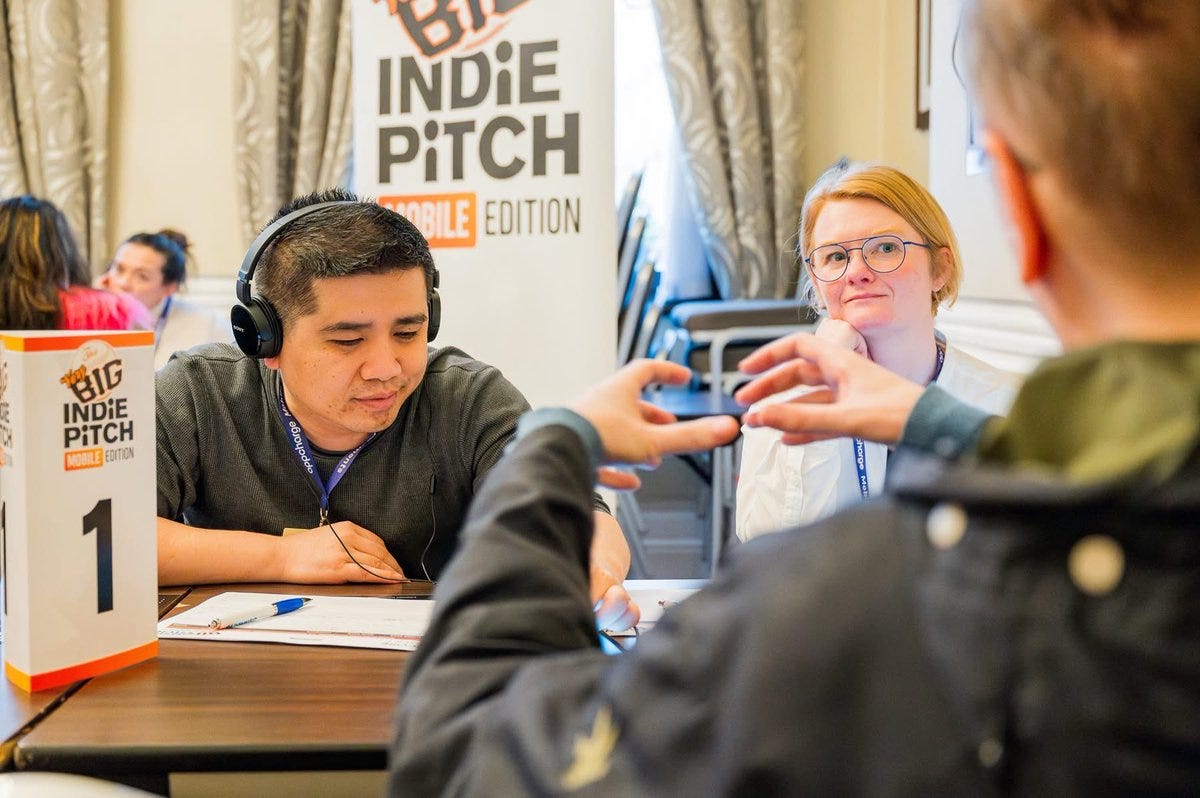
When it comes to finding investors, there is definitely more money floating about, though as Carli pointed out, AI tech stacks might be a more appealing proposition for investors than traditional studios making AI native games or incorporating AI tools in their production processes.
For start-ups in the business of AI tools for game development, Carli pointed out many considerations that investors take in account while evaluating them. The most important consideration, as is the case with publisher funding, is the team and the founder.
Stein: “I think first and foremost is always the team. What is the calibre and quality of the team that you're going to be working with? And ultimately, is the founder nimble? Can they pivot if they need to? Do they have deep expertise in the area they're going after? I call it the Founder Market Fit. Are they the right founder to be building the right product at the right time, for the industry that they're going after?”
Going by Carli’s opinion, the founder seems to take the centre stage in these scenarios as pitching a company is very different from pitching a game. The founder should be able to clearly articulate their company’s present value proposition, and also have the foresight to define how this value proposition evolves in the long run. Further, retention is a key consideration while assessing AI tech stacks for game development specifically.
Stein: “I think especially within the games industry, you'll find a tool that does, you know, really well for one type of animation or one type of character creation, but it's not as much of a whole platform that teams can collaborate on and build over time and can be used throughout the game development lifecycle. So I think about how sticky will this platform be, will it be used throughout the lifecycle of the game? Will it be something that people will come back to use continuously or only have to use once and then not think about it again? And so really that long term value and stickiness ultimately drives willingness to pay.”
Closing Thoughts
The games industry is hopefully coming out of what has been a pretty rocky couple of years, with investors and publishers being cautious and risk-averse and studio downsizing. Unlike other fields that have embraced it more readily - sometimes to their detriment - the games industry is continuing to navigate the minefield of ethical dilemmas and quality concerns that generative AI presents. While many a AAA publishers is heavily invested in generative-AI as the solution to their ills, the amount of investor interest in AI tech to enable game development is still strong. Meanwhile the concerns about generative AI replacing developers and the ensuing loss in quality are far from resolved.
What’s certain is that with the amount of funding generative AI is attracting, there is no future where it doesn’t embed itself into games and game development. Naturally at AI and Games we approach this with a more sensible and pragmatic view, where AI tools empower developers instead of replacing them - empowering them to create new types of player experiences - but it’ll be interesting to see what emerges, and who funds it, going forward.
Wrapping Up
Thanks once again to Amit for taking the lead on writing up this week’s main feature, and of course a special thanks to both Carli and Cassia for their time. This was a but a snippet of two much longer conversations, and we aim to bring them to you in the future.
In the meantime, thanks for reading
and we have some fun stuff lined up for you later this month. Including my recap of IEEE Conference on Games, another sponsor update, a deep dive into .



